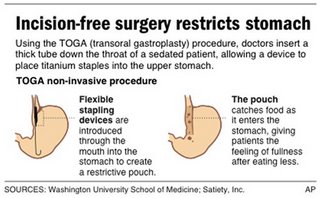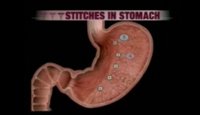No scars: New TOGA obesity surgery goes through mouth

Chicago, IL
Doctors are testing a new kind of obesity surgery without any cuts through the abdomen, snaking a tube as thick as a garden hose down the throat to snap staples into the stomach. The experimental, scar-free procedure creates a narrow passage that slows the food as it moves from the upper stomach into the lower stomach, helping patients feel full more quickly and eat less.
Doctors say preliminary results from about 200 U.S. patients and 100 in Europe look promising.
After about 18 months, obese European patients have lost an average of about 45 percent of their body weight, said Dr. Gregg Nishi, a surgeon at Cedars-Sinai Medical Center in Los Angeles. He discussed the European and U.S. studies during a Chicago conference this week for digestive disease specialists.
The procedure is only being done in the studies, which recently ended enrollment. Makers of the device used in the operation plan to seek federal approval if the research continues to go as planned.
While the two studies are still under way and only brief details are being released, Nishi said results so far are slightly better than typical results from with conventional stomach stapling.
Risks include perforating the esophagus, as Nishi said happened to a patient at another center, but otherwise, he said, there have been no major complications.
Some study patients have lost weight after unknowingly undergoing fake procedures — sedation and the tube, but no stapling. Results comparing them with the real thing aren't yet available.
Liliana Gomez, an administrative coordinator at Cedars-Sinai, was among the first Americans to have the scarless obesity surgery last year, as a test case for the U.S. study. She had planned on more invasive conventional surgery until learning that doctors at her hospital were studying the scarless stapling technique.
"When I found out it was going to be oral, through your mouth, I was like, 'Wow, that's kind of different,'" she said.
Since her operation in August, Gomez has lost about 40 pounds and dropped from size 22 to size 16.
The 35-year-old mother of three has a long way to go — she's still obese according to body mass index standards. But Gomez says she has cut her meal portions by more than half and still feels full, and is optimistic she'll continue to lose weight.
The new method is part of a medical movement to perform surgery through body openings such as the nose, mouth and vagina instead of making cuts. The idea is to reduce chances of infection and pain, and speed recovery. With no scars, there are cosmetic advantages, too.
Gomez had considered a gastric bypass operation, a more complex kind of stomach stapling, but worried about risks from that surgery. It reduces the stomach to the size of a golf ball and reroutes the digestive tract.
Whether done through one large abdominal incision or several tiny ones, gastric bypass is far more invasive and increases chances for malnutrition because it repositions how the stomach attaches to the intestines to restrict calorie absorption.
Another popular weight-loss surgery option involves putting an adjustable band around the top part of the stomach to create a small pouch.
The experimental method Gomez had is the oral version of a different kind of stomach surgery, which reduces the size of the stomach with staples but doesn't reroute the digestive system.
Surgery is generally considered a last-resort treatment for obesity, which affects more than 15 million Americans. Still, demand is high. More than 200,000 Americans are expected to have conventional forms of obesity surgery this year, according to the American Society for Metabolic & Bariatric Surgery.
Dr. Scott Shikora, the society's president, called the oral procedure exciting and innovative, but said, "It is too early for us to say this is going to be a breakthrough."
Shikora said many U.S. obesity surgeons prefer the rerouting surgery or flexible bands, and that it remains to be seen whether the oral method has the same drawbacks as more outmoded stapling procedures.
The U.S. study is taking place at 10 centers. Patients will be followed for at least one year, with final results expected in 2010. They are randomly selected to undergo either the operation or a sham procedure.
Nishi said of 25 patients enrolled at his hospital, 17 got the real treatment, with no complications.
"I'm very impressed with it," Nishi said. So far, it looks like "a viable alternative," he said.
Satiety Inc., a California company that created the medical devices used in the technique, is paying for the research. Nishi said he has no financial ties to the company.
At Washington University School of Medicine in St. Louis, where the first U.S. procedure was done last summer, about 30 patients have undergone the treatment. Side effects have been minimal, including sore throats, nausea and some abdominal pain lasting less than a week, said Dr. J. Christopher Eagon. He said weight loss results from his center aren't yet available.


